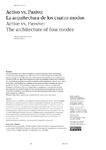Mostrar o rexistro simple do ítem
Activo vs. Pasivo: La arquitectura de los cuatro modos
| dc.contributor.author | Mensa Biosca, Pol | |
| dc.date.accessioned | 2023-02-24T19:42:51Z | |
| dc.date.available | 2023-02-24T19:42:51Z | |
| dc.date.issued | 2022-12-31 | |
| dc.identifier.citation | Santacana Juncosa, Amadeu, y Pol Mensa Biosca. “Activo Vs. Pasivo: La arquitectura de los cuatro modos.” BAC Boletín Académico.Revista de investigación y arquitectura contemporánea 12 (2022): 56-73. https://doi.org/10.17979/bac.2022.12.0.8859 | es_ES |
| dc.identifier.issn | 2173-6723 | |
| dc.identifier.issn | 0213-3474 | |
| dc.identifier.uri | http://hdl.handle.net/2183/32583 | |
| dc.description.abstract | [Resumen] Este artículo tiene como objetivo establecer una nueva catalogación de arquitecturas a partir de su forma de gestionar el clima con el fin de resituar la gestión climática del espacio y el papel de su habitante como material fundamental del proyecto arquitectónico. En un recorrido que sigue las investigaciones sobre las cualidades térmicas en los edificios de Lisa Heschong, pasando por los planteamientos sobre la pérdida de relación con el clima de Eva Horn, para finalmente complementar los modos de gestión climática propuestos por Reyner Banham. Se desarrollan ejemplos de los cuatro modos en su estado puro: Retardante, Hermético, Selectivo y Regenerativo; separándolos conceptualmente para incorporarlos como material arquitectónico de una manera necesariamente combinada. Y así volver a establecer una relación activa entre las experiencias habitables y la riqueza de las variaciones climáticas. | es_ES |
| dc.description.abstract | [Abstract] This article aims to establish a new register of architectures based on their way of managing the climate in order to relocate the climatic management of the space and the role of its inhabitant as a fundamental material of the architectural design. In a line that follows Lisa Heschong's research on building’s thermal qualities, passing through Eva Horn's views on the loss of relationship with the climate, to finally complement the climate management modes proposed by Reyner Banham. Examples of the four modes are developed in their raw condition: Retardant, Hermetic, Selective and Regenerative; separating them conceptually to incorporate them as architectural material in a necessarily combined way. And thus re-establish an active relationship between habitable experiences and the richness of climatic variations. | es_ES |
| dc.language.iso | eng | es_ES |
| dc.language.iso | spa | es_ES |
| dc.publisher | Universidade da Coruña | es_ES |
| dc.relation.uri | https://doi.org/10.17979/bac.2022.12.0.8859 | es_ES |
| dc.rights | Atribución-CompartirIgual 4.0 Internacional (CC BY-SA 4.0) | es_ES |
| dc.rights.uri | https://creativecommons.org/licenses/by-nc-sa/4.0/ | |
| dc.subject | Clima | es_ES |
| dc.subject | Arquitectura | es_ES |
| dc.subject | Termodinámica | es_ES |
| dc.subject | Negociación | es_ES |
| dc.subject | Variaciones | es_ES |
| dc.subject | Climate | es_ES |
| dc.subject | Architecture | es_ES |
| dc.subject | Thermodynamics | es_ES |
| dc.subject | Negotiation | es_ES |
| dc.subject | Variations | es_ES |
| dc.title | Activo vs. Pasivo: La arquitectura de los cuatro modos | es_ES |
| dc.title.alternative | Active vs. Passive: The architecture of four modes | |
| dc.type | info:eu-repo/semantics/article | es_ES |
| dc.rights.access | info:eu-repo/semantics/openAccess | es_ES |
| dc.date.updated | 2023-02-24T18:37:29Z | |
| UDC.journalTitle | BAc Boletín Académico. Revista de investigación y arquitectura contemporánea | es_ES |
| UDC.volume | Vol. 12 (2022) | es_ES |
| UDC.startPage | 56 | es_ES |
| UDC.endPage | 73 | es_ES |
| dc.identifier.doi | 10.17979/bac.2022.12.0.8859 |






